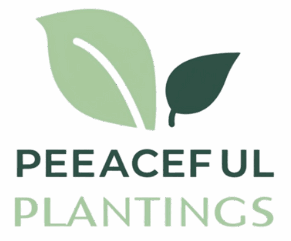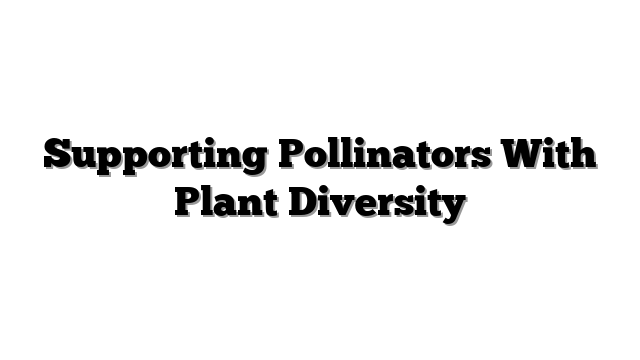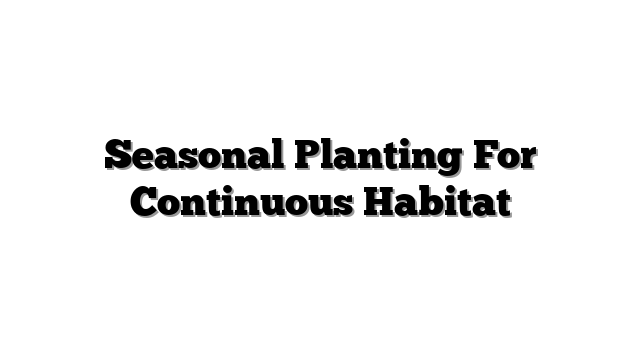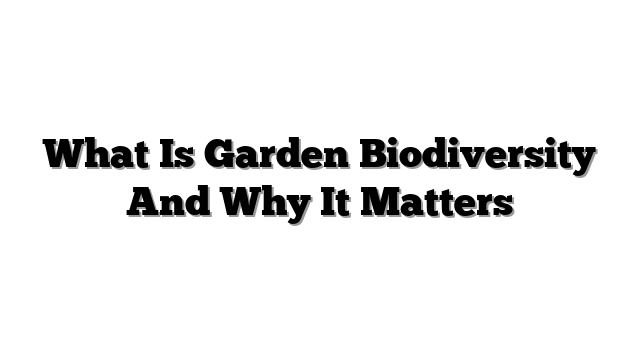Supporting Pollinators With Plant Diversity
Supporting Pollinators: Boost Biodiversity with Plant Diversity (2025 Guide)
Nature needs helpers. Bees buzz. Butterflies flutter by. Hummingbirds sip sweet liquid. These small visitors do big work. They move pollen. This helps plants grow seeds. Many foods need this help. Think apples, berries, almonds. Pollinators make these possible. Their numbers are falling. This is a big worry. Gardens offer hope. Every small space helps. Your garden can be a haven.
Habitat is disappearing. Food sources are few. Diverse plants offer a solution. Home gardeners hold power. We can make a difference. We use plant diversity. This guide helps you start. We cover why diversity matters. We pick good plants. We design the space. We care for it well. Join us. Help Supporting Pollinators with Plant Diversity. Grow a healthy garden. Help nature thrive.
Why Plant Diversity is Key to a Thriving Pollinator Garden
Variety matters a lot. Plant diversity means many different plants. They look different. They grow differently. They bloom at different times. This is good for gardens. It is great for pollinators.
Pollinators need food all year. Different plants bloom in spring. Others bloom in summer. Some bloom in fall. A diverse garden gives food. It feeds bees early on. It feeds butterflies late. Food is always ready. This helps them live. It helps them raise young.
Pollinators are not all alike. Some bees have long tongues. Some have short tongues. Butterflies need specific plants. They lay eggs there. Young eat the leaves. Different flowers fit different needs. Flower shape matters. Flower color matters. Diversity offers many choices. It welcomes more visitors.
A diverse garden is strong. It fights problems better. Pests might attack one plant. Other plants stay healthy. Diseases spread less easily. This makes the garden tough. It handles weather changes. It handles changing times. Your garden stays healthy. Pollinators find a safe place.
Plants offer more than food. They give shelter. Tall plants offer shade. Dense bushes hide nests. Groundcover protects insects. Some need bare ground to nest. Diverse plants create homes. They make a safe place to rest. They make places to sleep. They make places to hide.
Think about a lawn. It is just grass. It offers little food. It offers no homes. A garden with few plants is similar. It feeds only some. It helps only a few. A garden with many plants is different. It is full of life. It supports many kinds. It helps Biodiversity in the Garden. This benefits everything.
Selecting Plants for Pollinator Success: Native, Nectar, and Host Plants
Good plants bring pollinators. We choose them carefully. Native plants are often best. They grew here long ago. Local pollinators grew with them. They know these plants well. The food is perfect for them. Native plants need less care. They fit the local weather. They fit the local soil.
Find native plants for your area. Look at local nurseries. Ask plant groups for help. Websites offer lists too. Pick plants from your region. They help local wildlife most.
Other plants can help too. Not all plants must be native. Choose plants that are not invasive. Invasive plants spread too much. They hurt native plants. Pick non-native plants wisely. Make sure they are safe. They can add food later. They can fill bloom gaps.
Pollinators need two main things. They need nectar plants. Nectar is like sugary water. It gives them energy. Bees drink it. Butterflies sip it. Hummingbirds love it. Examples include Bee Balm. Lavender works well. Coneflowers offer nectar.
They also need host plants. Host plants feed the young. Butterflies lay eggs on them. Caterpillars eat the leaves. Milkweed is a host plant. Monarch butterflies need it. Parsley hosts Swallowtails. Fennel works too. Accept some chewed leaves. This means your garden is working. It is feeding baby pollinators.
Look at flower details. Single flowers are good. They have one layer of petals. Nectar and pollen are easy to reach. Double flowers have many petals. They look pretty. But food is often hidden. Pollinators cannot get it.
Flower shape matters. Bees like flat flowers. They like tube shapes. Butterflies like landing pads. Hummingbirds like tubes. Pick different shapes. Pick different colors too. Bees like blue and yellow. Butterflies like red and orange.
Plan for the year. Pick plants that bloom early. Pick some for summer. Pick plants for fall. This gives food all season. Make a list. Note bloom times. Note pollinator types they help. This helps with Plant Selection. It helps with Attracting Bees and Butterflies. Think about trees and shrubs too. They offer food and shelter. They are part of the plan.
Choose plants that are tough. Pick ones that handle your weather. Studies show climates are changing. Tough native plants survive. They keep feeding pollinators.
Pollinator Garden Design: Creating an Attractive and Functional Habitat
Planning makes a difference. Design your garden well. Think about what pollinators need. Make it easy for them.
Put plants in groups. Plant three or more of the same kind. Put them close together. This makes a big color patch. Pollinators see it easily. They spend less energy searching. It looks nice too.
Use plants of different heights. Put short plants in front. Put tall plants in back. Use bushes and small trees. This creates layers. Layers offer different places. They offer food high and low. They offer many hiding spots.
Know your sun and soil. Match plants to the right spot. Some need full sun. Some need shade. Some need wet soil. Some need dry soil. Healthy plants make more food.
Pollinators need water. Add a shallow dish. Put stones in it. Bees can land safely. Butterflies like muddy spots. They get minerals there. A wet area helps.
They need places to rest. Leave some bare ground. Ground-nesting bees use it. Put a log in the garden. Stack some stones. These offer shelter. They offer places to stay warm. They offer places to hide from rain.
You can garden anywhere. Big yards work well. Make different areas. Create meadows. Make flower borders. Small spaces work too. Use pots on a patio. Grow plants in boxes. Vertical gardening saves space. Grow plants up a wall. Every space helps.
Grow some food for yourself. Many food plants help pollinators. Herbs like basil flower. Bees love them. Dill flowers too. Borage is a bee favorite. Let some vegetables flower. They feed you and the bees. This adds to Garden Design. It adds to the habitat.
Sustainable Pollinator-Friendly Gardening Practices
How you care for your garden matters. Be kind to the earth. Be kind to pollinators.
Do not use bug sprays. Many sprays kill good bugs. They kill bees and butterflies. Even “natural” ones can hurt. Avoid weed killers too. They remove pollinator food. They remove host plants. Experts agree: skip the chemicals.
Healthy plants fight pests better. Give them good soil. Water them right. This helps prevent problems. If pests appear, try safe ways. Wash them off with water. Pick them off plants. Attract good bugs. Ladybugs eat aphids. This is Integrated Pest Management (IPM). It uses safe steps first.
Plants need water to live. They need it to make nectar. Water the soil, not the leaves. Water early in the morning. This saves water. Drip systems work well. They put water at the plant roots. Smart irrigation uses less water. It gives water when needed.
Leave your garden messy. Leave plant stems standing in fall. Leave leaves on the ground. Many pollinators hide in them. They spend winter there. They stay safe and warm. Clean up in late spring. Wait until the weather is warm. Wait until bugs wake up.
Manage unwanted plants. Pull weeds by hand. Be careful where you step. Bees might nest in the ground. Some “weeds” help pollinators. Clover helps bees. Let some grow in wilder spots.
Feed the soil, not just plants. Use compost. Add organic matter. Healthy soil makes healthy plants. Healthy plants feed pollinators well. Do not use too much fertilizer. Too much can hurt flowers.
These simple steps help. They create a safe place. They help your garden thrive. They support the little visitors. This is Pollinator-Friendly Gardening Practices. It helps build a Creating a Pollinator Habitat.
Creating a Larger Pollinator Habitat: Connecting Your Garden to the Ecosystem
Your garden is not alone. It is part of a bigger world. It links to other gardens. It links to natural areas. Every garden helps make a path. Pollinators use these paths. They travel safely. They find food along the way. We call these pollinator corridors.
Talk to your neighbors. Share what you learn. Ask them to plant flowers. Maybe plant similar flowers. Work together on your street. Create a neighborhood path. Community gardens help too. Support local efforts.
Lawns cover much land. They offer little to nature. Think about planting flowers instead. Change some lawn to garden beds. Use native plants there. This makes a big impact. It gives more food. It gives more homes.
Help local groups. Join native plant societies. Support nurseries selling native plants. They work to protect nature. Your help matters.
Share your knowledge. Tell friends what you do. Show them your garden visitors. Inspire others to help. Small actions add up.
Watch your garden. See the bees and butterflies. See the birds visiting. Count the different kinds. Enjoy the life you attract. Feel good about your work. Your garden is a success. You are helping nature.
More people help nature now. Cities plant wildflowers. Communities build wild spaces. This is urban rewilding. It connects areas. Your garden joins this trend. It makes the world better. You help Biodiversity in the Garden. You help the whole area.
Common Questions About Supporting Pollinators with Plant Diversity
You might have questions. Many gardeners do. We answer common ones here.
What plants are best to start with? Try easy native plants. Coneflowers work well. Milkweed is great for Monarchs. Salvia attracts many bees. Sunflowers are tall and helpful. Bee Balm is a favorite. Pick 3-5 easy ones.
Can a small space help? Yes, totally. A balcony helps. A window box helps. One pot helps. Pick just a few plants. Choose ones with long bloom times. Every flower matters. Vertical gardening uses little ground space.
How do I stop bugs without spray? Use water first. Spray pests off leaves. Pick big bugs by hand. Use insecticidal soap carefully. Use it only on pests. Use it when pollinators are not active. Attract good bugs to eat bad bugs.
Are native plants always best? Natives are usually best. They fit local needs. Some non-native plants help. They must not be invasive. They can add to food options. Choose native most often.
When should I clean my garden? Wait until spring. Leave old stems and leaves. Many insects sleep in them. Clean up when it is warm. Wait until new growth starts.
Cultivating Change: Your Role in Supporting Pollinators Through Plant Diversity
We need pollinators. Our food needs them. Nature needs them. Their future looks hard. We can help them. Our gardens offer hope.
Plant diversity is powerful. Many different plants help many different visitors. They give food all year. They offer homes. Native plants are key. They fit local needs best. Design your space well. Think like a pollinator. Provide food, water, shelter.
Care for your garden gently. Do not use harmful sprays. Water wisely. Leave plant stems in winter. Let nature rest there.
Your garden does not work alone. It connects to others. It helps make a network. Every garden helps. Big or small, it matters. You help the ecosystem. You help gardening for wildlife.
Start today. Plant one flower. Observe who visits. Learn more about native plants. Share your story. You are making a difference. You are Supporting Pollinators with Plant Diversity. Your garden will buzz. It will flutter. It will be full of life. It will be beautiful.




